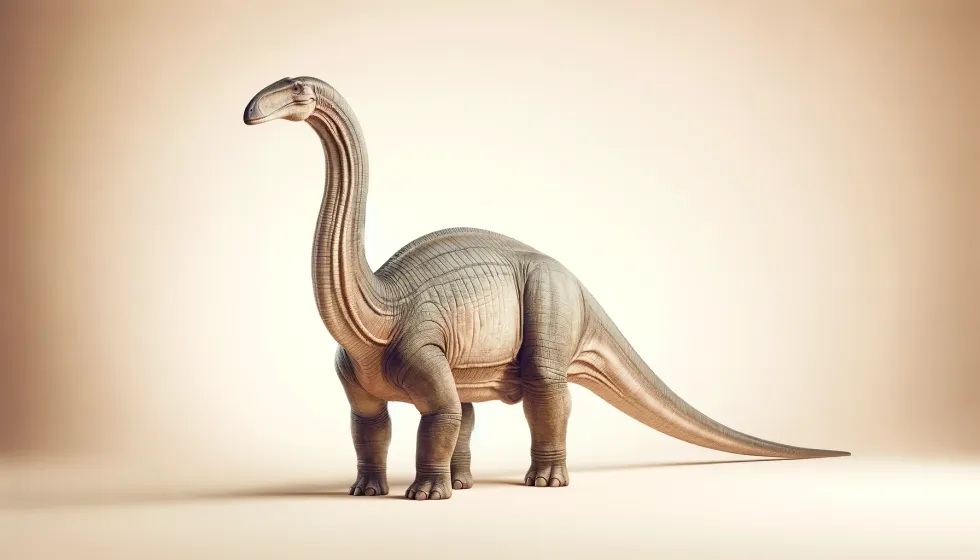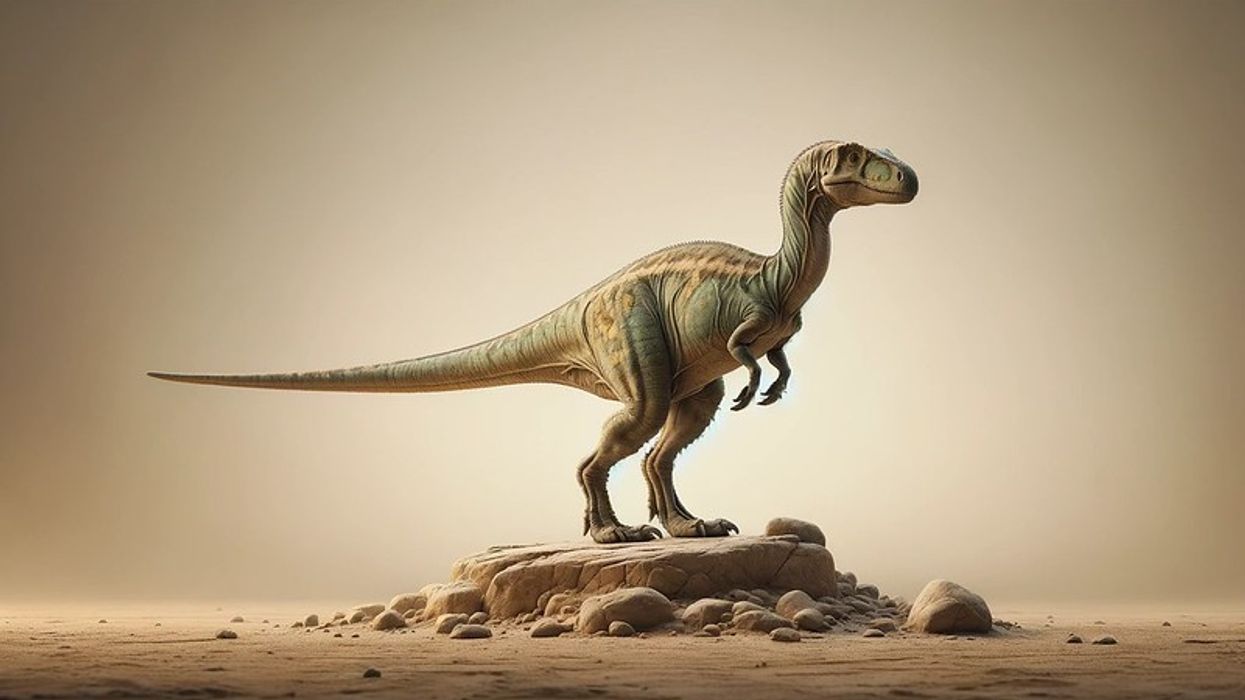Sauropod dinosaurs have captivated the attention of scientists and the public alike, with their vast size and unusual body structures, featuring a long neck and tail. Aegyptosaurus, meaning 'Egypt’s lizard', is one of the most mysterious giants that roamed the Sahara Desert during the Late Cretaceous Period (100.5-66 million years ago).
Its existence was unveiled through the limited known examples of fossils described from the Bahariya Formation (also known as Baharîje Formation) in areas like the Central Sahara, yet much about this larger dinosaur remains a mystery.
Notably, many historical remnants of the Aegyptosaurus were destroyed during an Allied bombing raid in World War II, leaving a fragmented window into the life of this fascinating creature.
Aegyptosaurus Interesting Facts
How do you pronounce 'Aegyptosaurus'?
It is pronounced as 'ee-JIP-toe-SAW-rus'.
What type of dinosaur was it?
It was a sauropod dinosaur, classified under the group of titanosaurids.
In which geological period did this dinosaur roam the Earth?
It roamed the Earth 98-93 million years ago during the Late Cretaceous Period (100.5-66 million years ago).
When did the Aegyptosaurus become extinct?
This dinosaur went extinct around 95 million years ago in the Cenomanian stage (existing 100.5-93.9 million years ago) of the Late Cretaceous Period before the major extinction that ended the Cretaceous around 66 million years ago.
Where did this dinosaur live?

Its fossils were found in Northern Africa's Sahara Desert, especially in Egypt's Bahariya Formation and Niger's Farak Formation.
What was their habitat?
This dinosaur inhabited semi-arid environments within the Sahara Desert, which during the Cretaceous Period would have been lush and had seasonal water sources.
How long did this dinosaur live?
The actual lifespan of Aegyptosaurus, a species of sauropod dinosaur, is uncertain. However, it is believed that it may have had a lifespan similar to that of other sauropods, which could survive for several decades.
Further paleontological research may eventually provide insights into this detail.
How did they reproduce?
This dinosaur relied on egg-laying as its reproduction mode, a common trait shared by many other dinosaurs, birds, and crocodiles.
The eggs laid by Aegyptosaurus were most likely incubated and hatched outside the body, just like how birds and reptiles reproduce.
Aegyptosaurus Fun Facts
What did they look like?
Aegyptosaurus had a characteristically long neck and tail, a small head with a potentially massive body mass supported by strong, pillar-like legs. This animal's long tail likely served as a balancing mechanism to offset its body weight.
How many bones did an Aegyptosaurus have?

The Aegyptosaurus is a fascinating dinosaur species, but due to incomplete fossil records, the exact number of bones in its skeleton remains uncertain.
However, with ongoing research and advancements in technology, we may soon gain more insight into the skeletal properties of this remarkable creature.
How did they communicate?
There is no solid evidence to suggest how Aegyptosaurus communicated with one another. However, they likely relied on a combination of sounds, gestures, and visual cues, much like other dinosaurs and their modern-day descendants.
Further research and analysis of fossil records may shed more light on the nature of their interactions and communication systems.
How big was an Aegyptosaurus?

The Aegyptosaurus was around 50 ft (15 m) long, although the size might have varied depending on individual age and development.
How fast could this dinosaur move?
The speed at which Aegyptosaurus moved is still unknown to researchers, but based on its characteristics as a large, herbivorous sauropod dinosaur, it is believed to have had a slow and leisurely movement.
As a quadrupedal (using four limbs for locomotion or movement) animal with a massive body and long neck, Aegyptosaurus likely moved at a strolling pace, using its powerful legs to support its weight and move forward.
However, due to limited fossil evidence, it is difficult to determine the exact speed at which Aegyptosaurus could travel.
How much did an Aegyptosaurus weigh?
The herbivorous Aegyptosaurus, a member of the sauropod group of dinosaurs, had an estimated weight of 15,432 lb (7,000 kg).
What were the male and female names of the species?

According to scientific research, the Aegyptosaurus, a species of dinosaur that existed millions of years ago, did not have distinct male and female names. In other words, both males and females of the species were referred to as Aegyptosaurus.
This is a common practice in paleontology, as the physical differences between male and female dinosaurs are often difficult to discern due to the incompleteness of the fossil record. Therefore, researchers refer to both sexes simply by the name of the species.
What would you call a baby Aegyptosaurus?
When an Aegyptosaurus was born, it would have been called a hatchling. As it grew older, it would have been referred to as a juvenile. A baby Aegyptosaurus would have been quite small compared to the adult size of the species, but it would have had many of the same characteristics as its parents.
Although not much is known about the early life of Aegyptosaurus, it is likely that the hatchlings were cared for by their parents until they were able to fend for themselves.
How aggressive were they?

Aegyptosaurus was a herbivorous dinosaur that was probably peaceful towards animals outside of territorial or mating disputes. These gentle giants were known for their passive and non-aggressive behavior.
As herbivores, they mostly consumed plants and vegetation, and their teeth were well-suited for grinding plant matter. Due to their massive size, they were likely not threatened by any predators, which allowed them to live a calm and relaxed life.
Despite their intimidating appearance, Aegyptosaurus was not considered a dangerous dinosaur and was known to coexist peacefully with other species in their ecosystem.
Did You know...
Ernst Stromer, who discovered Aegyptosaurus, dubbed it 'Egypt's lizard' due to its origins in Egypt. Tragically, the initial Aegyptosaurus fossils and other vital discoveries by Stromer were destroyed when an Allied bombing raid destroyed the museum housing them in 1944, during World War II.
The Bayerische Akademie der Wissenschaften (Bavarian Academy of Sciences) is significantly linked to the Aegyptosaurus through the work of Ernst Stromer, a German paleontologist.
Stromer published his findings on the Aegyptosaurus in the academy's journal, specifically in the Abhandlungen der Bayerischen Akademie der Wissenschaften Mathematisch-naturwissenschaftliche Abteilung.
His research included detailed descriptions of the Aegyptosaurus fossils he discovered in Egypt, which were later destroyed during World War II.
The Akademie der Wissenschaften Mathematisch refers to the mathematical-scientific section of the Bavarian Academy of Sciences where Stromer's work was published. This publication is crucial as it contains the original detailed descriptions and scientific documentation of the Aegyptosaurus, which became the primary source of information after the physical specimens were lost during the bombing of Munich in 1944.
Stromer was also known for his work 'Stromers In Den Wüsten' detailing the Sahara's geology and paleontology, and he was a member of the Bavarian Academy Of Sciences And Humanities (Bayerische Akademie Der Wissenschaften).
The term 'du Sahara central' relates to the central Sahara region where similar fossils of Cretaceous dinosaurs have been found, though not specifically Aegyptosaurus. This region's paleontological significance is highlighted in various studies, including those that mention Aegyptosaurus, as it provides context and comparisons for understanding the distribution and ecological environment of Cretaceous dinosaurs in North Africa
The Aegyptosaurus was closely related to the Argentinosaurus, which was a much bigger dinosaur discovered in South America.
FAQs
What did this dinosaur’s diet consist of?
Primarily a herbivore, this dinosaur likely feasted on the abundant vegetation of its era, such as conifers, ginkgoes, and cycads prevalent during the Late Cretaceous.
How did this dinosaur compare in size to other known dinosaurs of its time?
While it was sizable, this dinosaur was not the largest of its time, falling somewhere mid-range when compared to the massive titanosaurs and smaller herbivores.
Could this dinosaur defend itself against predators?
Yes, like many sauropods, it could defend itself against predators using its strong tail and bulk, though its primary defense was possibly its sheer size.
Were there any unique features that distinguished this dinosaur?
It stood out due to its long neck, which it used to reach high vegetation, and the unique patterning of its vertebrae and limb proportions as evidenced by fossil records.
How was the climate during the time this dinosaur lived?
The climate was warmer, with higher sea levels creating numerous shallow inland seas; this dinosaur's habitat was likely a mix of arid to semi-arid conditions with wet seasons.
What implications did the Allied bombing have on our understanding of this dinosaur?
The loss of original fossils in the bombing significantly limited the amount and quality of scientific information available, hindering a full understanding of its biology and ecology.
How have newer fossil discoveries contributed to our knowledge of this dinosaur?
Recent finds have helped paleontologists understand its growth, behavior, and possible kinship with other sauropods, slowly piecing together its evolutionary history.
Did this dinosaur live alone or in groups?
While there is no definitive evidence, it's plausible that this dinosaur lived in groups or herds, as suggested by the behavior of similar sauropods of its era.
What role did this dinosaur play in its ecosystem?
As a large herbivore, it likely played a significant role in shaping the vegetation, contributing to the propagation of plants through seed dispersal and maintaining the health of its habitat.
How do scientists estimate the body mass of this dinosaur without complete fossils?
Scientists use comparisons with closely related dinosaurs for which more complete fossils exist, along with computer models that simulate body mass and structure based on skeletal remains.
Although only scant fossils have been found, and there have been considerable setbacks due to remnants of war, each fragment uncovered adds to the broader picture of this dinosaur's existence.
Continued studies on the Aegyptosaurus highlight the resilience and marvel of life millions of years ago, reflecting the vulnerability of historical memory and the enduring legacy of the natural world.
Related Articles Around the Web















